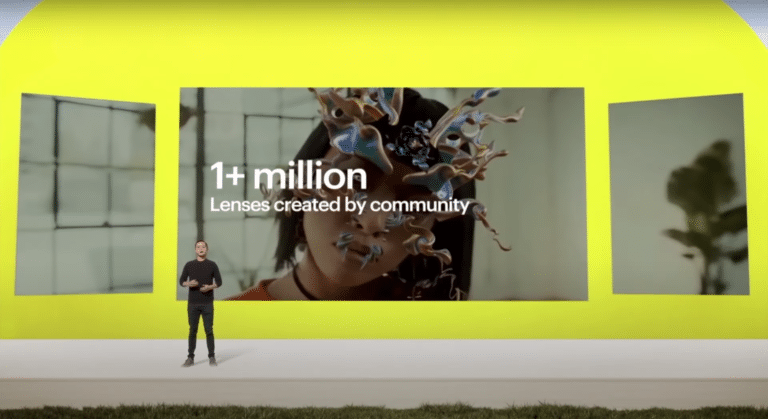
Data Dive is AR Insider’s weekly dive into the latest spatial computing figures. Running Mondays, it includes data points, narrative insights and takeaways. For an indexed collection of data and reports, subscribe to ARtillery Pro.
Snapchat continues to double down on AR. Lenses are the most popular flavor of consumer AR, and Snapchat is in turn the usage, engagement and revenue leader. Though Facebook has greater overall scale and reach, Snapchat has more AR traction according to ARtillery estimates.
This has a lot to do with its focus on AR. The technology aligns well with Snap’s camera-company designation and camera-forward use case. Moreover, it has introduced AR in organic and additive ways to the already-prevalent activity of multimedia social sharing — thus easing user adoption.
To validate that focus, Snap devoted a big chunk of stage time at last week’s annual developer conference to Lens evolution and updates. This follows similar emphasis at last year’s event, but with the additional “meta” subtlety of a keynote that itself was delivered with AR overlays.
We’ll unpack the full keynote in our XR Talks series later this week. Until then, it’s worth noting — in the spirit of our Monday Data Dive — the latest stats. First, one million lenses have been created to date. This follows 500,000 in Q3 2019 and 100,000 in 2018 — an accelerating pace.
https://www.youtube.com/watch?v=l7cd65DdP2w
Developer Friendly
Drilling down on that accelerated pace, Snap is driven to fuel its lens business by stimulating community creation. That’s involved a series of releases and evolutionary steps for Lens Studio including creator profiles for better discovery, and compelling lens creation tools.
This latest batch of updates includes lens textures and functionality. With Snap ML, developers can bring their own machine learning. So those that want to play inside of Snap’s walled garden for additional traction and distribution can migrate existing software into Lens Studio.
Snap likewise benefits in lowering barriers to lens experience creation. Snap ML launch partners include Wannabe’s popular shoe try-on AR app, and Prisma’s signature artistic selfie renderings. Altogether, Snap wins from a broader slate of AR, and developers win from greater distribution.
Catering to developers is also part of Snap’s AR virtuous cycle. Lens creation attracts users, which attract advertisers. The latter can access the same tools in Lens Studio to create immersive brand experiences and are compelled to do so, given the ability to reach a large lens-forward user base.
This wasn’t always the case as Snap initially kept lens creation in-house. In fact, it mentioned several times how Lens Studio unlocks its internal lens creation tools for creators. As a sidenote, TikTok is now in that internal lens-creation stage, but could scale significantly when it opens up.
Ultimate Enticement
Beyond developers, next in line in the virtuous cycle is users where Snap likewise sees growth. It announced at the same event that it has 170 million daily active AR users. This is up from 163 million at the end of Q1 and represents the most active usage for any consumer AR product.
Snap also repeated an existing stat to reiterate the degree of AR engagement: Active lens users engage 30x per day. This is the figure among all others that characterizes Snapchat’s strength as a consumer AR play. And it’s the ultimate enticement for brand advertisers, per the virtuous cycle.
In all of the above, Snap is also following the money. That’s partly a matter of the feedback loop for AR’s role in the company’s revenue growth and 2019 stock market rebound. And it’s partly a matter of a long-term positioning for AR to be a central component of its camera company vision.
Stay tuned later in the week when we’ll deconstruct the full AR segment of Snap’s keynote. That will include the play-by-play and color commentary on strategic implications. Meanwhile, check out ARtillery’s report that dives deep on learnings and best practices from Snap’s early AR lead.
